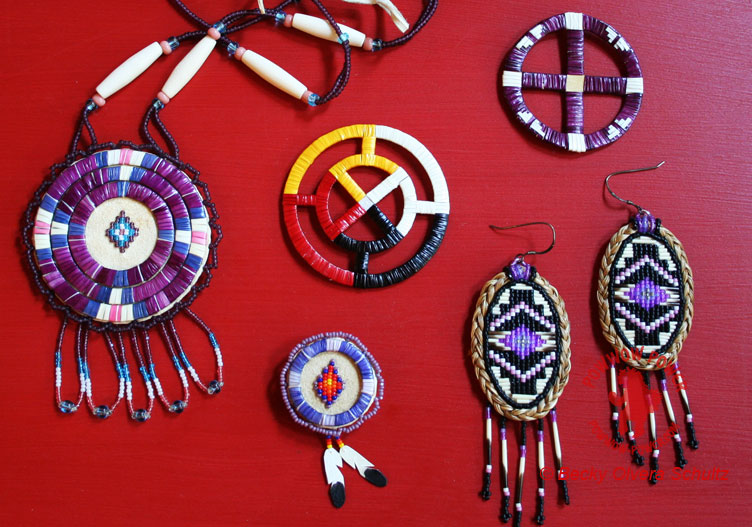Quillwork
Native American Quillwork
Before Native Americans acquired glass beads, they embellished their clothing and objects with quillwork. Quills from the porcupine were used and so were bird quills. This was probably the oldest form of Native American embroidery. Quills could be twisted, folded, plaited and wrapped to create a wide range of patterns on many items including clothing, moccasins, baskets, tool handles, pipe stems, bags, mats, horse gear and birch bark containers.
The quills had to be washed, dyed and flattened, usually by running them through one’s teeth but special tools were also used to flatten the quills. The natural color of porcupine quills range from white to pale yellow with the tips being black. The quills were dyed with natural elements derived from plants until aniline dyes were available through trade. Holes would be punched through the hides or bark and sinew was used to attach the quills until thread was available. Quillwork is considered a lost art but there are many Native Americans who still practice this old craft.
One wonders how the quills of the porcupine were obtained prior to being able to purchase them. Of course finding a dead porcupine is one way but native women seeking porcupine quills used the sneak-up method. They would cautiously sneak up behind a porcupine and throw a blanket over it. The natural defense of the animal would be to raise it quills, which would get caught in the blanket. When they removed the blanket, they simply had to pull out the quills that got stuck in the blanket.
Obviously porcupine quills are a valuable find on the road. A dead porcupine will not remain on the road for long. Once while traveling in New Mexico near the four corners area, we spotted a dead porcupine on the side of the road. I told my husband to turn around and go back. In the five minutes in took to backtrack, some industrious artisan had already removed the animal off the road.
The basic techniques of quillwork are zigzag, simple band, single thread line, wrapping and plaiting.
Zigzag: This is the simplest, most versatile and most natural form of quill work and the sturdiest. It can be worked into many shapes.
Simple Band or Parallel: This technique looks simple but flaws are easily detected and care must be taken to select quills that are similar in width and color. It is similar to the zigzag technique except the quills on the top row are folded away from you rather than toward you.
Single Thread Line: This is executed the same way as the band/parallel technique except one thread is used instead of two. The quill is also left whole instead of the tips being trimmed until the work is completed.
Wrapping: This technique enables one quill to be wrapped upon itself; two quills can also be intertwined.
Plaiting: This type of quillwork has the appearance of being woven. It’s one of the fastest to execute once one has mastered the skill, even though it looks complicated. It uses the single band/parallel or zigzag technique but many quills are used throughout the work rather than just one or two quills at a time.



